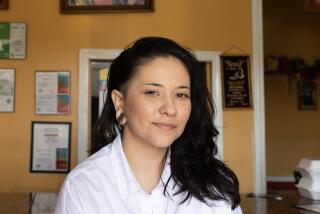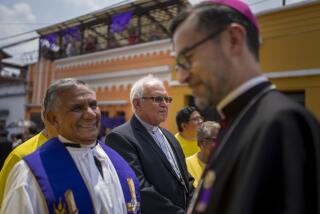Santeria Faith Emerging From Shadows : Religion: Supreme Court decision to allow animal sacrifices boosted centuries-old rituals. Experts say it has 1 million adherents nationwide.
MIAMI — The sign inside Gerardo Lastra’s botanica advertises discounted prices on live ducks and female goats for sacrifices to Yemaya, the Santeria god of the seas.
Shoppers short on cash can use American Express, Visa or MasterCard to charge their animals or purchases of good-luck sprays, colognes that chase away evil spirits or herbs for Santeria rituals. Lastra’s store, which sells ducks for $10 each and goats for $70 each, even delivers.
“Business is good,” says Lastra, standing amid a crowd of statues representing various deities. Behind his dusty store in Miami’s rundown Allapattah neighborhood, Lexus luxury sedans are as common in the parking lot as broken-down Buicks.
“We have lawyers, doctors, policemen coming in here,” he says. “You’d be surprised at the people who practice this religion. They see the proof of what it can do.”
Two years after the U.S. Supreme Court struck down laws banning religious animal sacrifices, the centuries-old Afro-Caribbean religion of Santeria is coming out of the shadows.
“There’s a collective feeling that the Supreme Court ruling did cause a psychological change in the way people think,” says Ernesto Pichardo, the man who took the fight for Santeria to the Supreme Court. “People are more open.”
Santeros now number about 100,000 in South Florida and 1 million nationwide, says anthropologist Rafael Martinez, who has worked with the Dade County (Miami) Medical Examiner’s Office investigating crime scenes linked to Afro-Caribbean religions.
Some practitioners are trying to persuade the general public that Santeria is a true religion and not a cult steeped in devil worship. They advocate certifying priests and establishing public churches.
But other Santeros oppose these efforts and want to keep their rites shrouded in mystery.
Born of a marriage of Roman Catholicism and religions practiced by West African slaves brought to the Caribbean, Santeria has evolved into a distinct faith.
Slaves prayed to their gods from the Yoruba culture, in what is now Nigeria, but adopted Roman Catholic saints as equivalents to appease their masters bent on converting them to Christianity. St. Barbara became Chango, the warrior god of thunder and lightning. And St. Lazarus became Babalu-Aye, patron of the sick.
The saint worship that developed in Santeria centers on seven deities with responsibility for various forces in nature.
From your health to your love life, there is a remedy prescribed by the orishas, as the saints are called.
Juan Guadalupe says he converted to Santeria because of health and emotional problems.
“It changed my life,” says the 39-year-old accountant clerk for Dade County’s Department of Human Resources. “I didn’t know what I wanted in life.”
Guadalupe says something happened to him during his initiation ceremony that made him a different person. But he won’t give details of the initiation rites.
“It’s secret,” he says. “But something happens with possession of the spirit that changed me. Before I was initiated I was introverted. I was afraid to speak my mind. Now I’m more open. . . . I value myself much more.”
The santera who initiated Guadalupe says most practitioners turn to Santeria because of health problems.
“There are few who come just for the religion’s background,” says Jackie Rodriguez, who has converted a room next to her garage into a small temple. “In many cases, the religion has the power to help out when doctors have little hope for them.”
After she had five miscarriages, Rodriguez says her doctors told her that she would never have children.
“The orishas told me in my initiation that I would have three children,” she says. “I’ve had three.”
Although Rodriguez and Guadalupe are deeply devoted to Santeria, they still consider themselves Roman Catholic.
Rodriguez says the church may not like it, but the two religions are intertwined. Before a person becomes initiated in Santeria, he or she must be baptized in the Catholic Church. On the last day of Santeria’s seven-day initiation period, the first place that a newly initiated person goes is to a Roman Catholic Mass.
The Rev. Michael Curtin, director of the Catholic Information Center in Washington, said, “The only connection between Catholicism and Santeria is in the mind of those who practiced Santeria. Anything that is superstition is contrary to Catholic doctrine, everything that is like pulling a lever to get a result is superstition.”
The Rev. Juan Sosa, executive director of the Ministry of Worship and Spiritual Life in the Archdiocese of Miami, said, “We’re dealing with a syncretism, a mixture of two religious views. They don’t see a contradiction, but there certainly is a contradiction in faith and doctrine. Catholicism believes in one God and Santeria believes in a number of gods.
“It seems to be a religion of fear.”
In years past, Rodriguez says, Santeria ceremonies were hidden in fear that police would disrupt the gathering to seize animals intended for sacrifice to the gods.
But Pichardo says his Church of the Lukumi has grown enormously since his Supreme Court victory. Membership has reached 6,000 and includes practitioners from Miami’s large Cuban exile community, suburban New Jersey, Chicago, Venezuela and Panama.
The Church of the Lukumi has begun certifying priests and Pichardo’s board of babalawos, or high priests, have given themselves the authority to expel any priest not following rules of certification. Certification costs $250.
Pichardo’s certification rules have angered many other practitioners.
“I think all santeros have to be grateful for what he did,” says Rodriguez. “But I don’t know why he would be the only person who decides who’s a priest.”
One santero expelled by Pichardo’s church contends that Pichardo is trying to profit from Santeria by controlling the religion.
“He wants to make a monopoly of this religion. Who gave him the right? Santeria doesn’t have temples. Santeria works in each person’s home,” says Rigoberto Zamora, who was expelled by Pichardo after he sacrificed animals for live television cameras in celebration of the Supreme Court victory.
But Zamora himself has taken the religion into the modern world of nonprofit grass-roots organizations. His International Union of Yoruva Religion Rights has a small office on Calle Ocho, or Southwest Eighth Street, in Miami’s Little Havana neighborhood.
Jose Montoya, a santero who runs a church in the Miami suburb of Hialeah, also says he is leading an effort to organize Santeria in Cuba.
“I opened this church because it gave me a place, as a priest, to show society that this is a religion of people who have high levels of education, that there are all types of people,” he says. “There are still those who think this is a cult.”
Montoya has written a 200-page constitution for a proposed Cuban church that he hopes will win the approval of Cuban leader Fidel Castro.
Montoya’s Church of Chango Eyife is housed in a small storefront among the shops, hair salons and restaurants of downtown Hialeah, just one block from City Hall, where government leaders tried unsuccessfully to ban religious animal sacrifices.
The fight among the Miami area’s most prominent santeros seems pointless to some.
“I don’t think this church thing will ever work out,” Rodriguez says. “I don’t think we can ever have one church we can all go to. This is a tribal thing.”
Scholars who have studied Santeria are split over whether the religion can truly be brought out of the shadows into mainstream American life.
More to Read
Sign up for Essential California
The most important California stories and recommendations in your inbox every morning.
You may occasionally receive promotional content from the Los Angeles Times.










